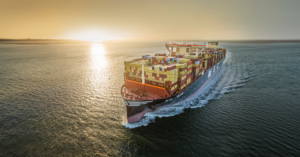After more than 30 green corridor plans announced over the past two years, partners are beginning to see the challenges more clearly.
High on the buzz of a new industry catchphrase, shipping stakeholders have been swept up in green corridor fever. At COP27 alone, more than 13 bilateral announcements were made as part of the Green Shipping Challenge. Now it appears some of those projects may be foundering amid the complexities of data sharing and short-term goal alignment.
The case for such corridors remains strong. A joint statement signed by maritime and green hydrogen companies at COP 27 challenged ship operators to aim to use zero emissions fuels representing five percent of their total consumption by 2030. To enable this, hydrogen producers pledged to deliver 5.5 million tonnes of green fuels by then. The Rocky Mountain Institute (RMI), the instigator of the challenge along with a UN climate change panel, estimates that 20-30 green corridors will need to be established by 2030 to use the fuel.
“This a huge coordination challenge and we need to start planning now, without delay,” said Oleksiy Tatarenko, Senior Principal, RMI, who runs the institute’s Climate-Aligned Industries Program.
To assist in that process, RMI has teamed up with the Maersk Mc-Kinney Møller Center for Zero Carbon Shipping and the Green Hydrogen Catapult to develop a guide to creating a green corridor pre-feasibility blueprint. The guide will be useful for many of those that rushed to announce projects, according to Johan Byskov Svendsen, Progamme Manager, Green Shipping Corridors at the Maersk centre.
“We saw some of corridor projects struggling in actually finding out exactly what to do and how to move forward,” he said. “It’s paramount that we get a number of projects up and running and get them further from just being thoughts.”
Tight timeframes
The need for urgency is clear. It can take anywhere from three to eight years to establish a single green fuel production plant, according to Alex Hewitt, Chairman of the Green Hydrogen Catapult. Hapag-Lloyd decarbonisation lead Martin Koepke cited a four-and-a-half-year timeframe to realise a newbuild vessel capable of using the fuels. That leaves little breathing space ahead of an ambitious 2030 target for alternative fuel use.
It also leaves ship operators and fuel producers in a stand-off over who invests first. Green corridors are one mechanism that can be used to break the deadlock. But navigating such multilateral projects is fraught with pitfalls.
C40, which describes itself as acting like a ‘green corridor incubator’, is currently facilitating the development of two corridors, connecting ports in Los Angeles and Long Beach with counterparts in Singapore and Shanghai. Alisa Kreynes, Director of Ports and Shipping, C40, notes that both projects are progressing well. An implementation plan is due to be published for the LA-Shanghai corridor, while the more recent LA/Long Island-Singapore corridor is still in the scoping phase. But she highlights some of the challenges such complex negotiations can face.
“Developing commitments to meet near-term goals is definitely a challenge,” she says. “Partners may be well aligned on their ambition overall but have different pathways to reaching the goal. This is something we’re working to figure out on the LA-Shanghai corridor where we aim to define our goals for 2025 and 2030.”
Data sharing is another area where green corridors can struggle. Digital solutions are needed by all stakeholders to optimise efficiency and minimise emissions. But agreeing on a common data process that is secure, transparent and robust can be a challenge for companies with well-established ways of working of their own. The LA-Singapore corrdior project specifically targets these issues with a joint project on digital collaboration.
Breaking barriers
There have been early successes too. Kreyne is encouraged by the ability of green corridor coalitions to work with stakeholders across cultural, political and public-private boundaries. The emergence of unified stakeholder groups facilitiating knowledge sharing, leveraging scale and lobbying for policy is another encouraging sign.
There is clearly much to gain from a widespread network of green corridors. Most obviously in their potential to put new fuels, infrastructure, technology and policy in place, at pace. They might also support land-based decarbonisation, if green initiatives ripple outwards from port facilities and fuel generation to other ancillary industries.
To realise those advantages to the full, projects need to begin in a way that sets them up to navigate the thorny issues ahead. The new green corridor pre-feasibility guide may be the ideal place to start.
Related stories



Axpo commissions small-scale LNG vessel

MSC joins SEA-LNG as latest coalition member

ITIC and ICS to host panel discussion during LISW


































